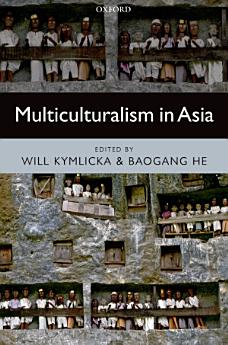Multiculturalism in Asia
Will Kymlicka · Baogang He
ਅਕਤੂ 2005 · OUP Oxford
ਈ-ਕਿਤਾਬ
376
ਪੰਨੇ
family_home
ਯੋਗ
info
reportਰੇਟਿੰਗਾਂ ਅਤੇ ਸਮੀਖਿਆਵਾਂ ਦੀ ਪੁਸ਼ਟੀ ਨਹੀਂ ਕੀਤੀ ਗਈ ਹੈ ਹੋਰ ਜਾਣੋ
ਇਸ ਈ-ਕਿਤਾਬ ਬਾਰੇ
This volume explores the different ways that ethnic and religious diversity is conceptualized and debated in South and East Asia. In the first few decades following decolonization, talk of multiculturalism and pluralism was discouraged, as states attempted to consolidate themselves as unitary and homogenizing nation-states. Today, however, it is widely recognized that states in the region must come to terms with the enduring reality of ethnic and religious cleavages, and find new ways of accommodating and respecting diversity. As a result, many countries are now debating policies to accommodate minorities, including recognition of indigenous rights, minority language rights, consociational power-sharing, regional autonomy, and multination federalism. This is often described as a key ingredient in any process of democratization in the region. One manifestation of this new ethos is the growing rhetoric of 'multiculturalism', often imported from the West. And indeed Western models of minority rights have had an influence in many Asian countries, often promoted by international organizations. However, Asian societies also have their own traditions of peaceful coexistence amongst linguistic and religious groups. All of the major ethical and religious traditions in the region - from Confucian and Buddhist to Islamic and Hindu - have their own conceptions of tolerance, and their own recipes for sustaining unity amidst diversity. These traditions continue to shape people's beliefs and practices in the region. Even the distinctive conception of Marxism developed in the region provides an influential perspective on these issues not found in the West. The rhetoric of 'multiculturalism' may be ubiquitous around the world, but it is being used to express quite different ideas and norms. Using both case studies and thematic essays, this volume examines the pre-colonial traditions, colonial legacies, and post-colonial ideologies that influence contemporary debates on multiculturalism in the region. It explores the areas of convergence and divergence between these different perspectives, and the extent to which they provide viable frameworks for managing ethnic and religious diversity in the region.
ਇਸ ਈ-ਕਿਤਾਬ ਨੂੰ ਰੇਟ ਕਰੋ
ਆਪਣੇ ਵਿਚਾਰ ਦੱਸੋ
ਪੜ੍ਹਨ ਸੰਬੰਧੀ ਜਾਣਕਾਰੀ
ਸਮਾਰਟਫ਼ੋਨ ਅਤੇ ਟੈਬਲੈੱਟ
Google Play Books ਐਪ ਨੂੰ Android ਅਤੇ iPad/iPhone ਲਈ ਸਥਾਪਤ ਕਰੋ। ਇਹ ਤੁਹਾਡੇ ਖਾਤੇ ਨਾਲ ਸਵੈਚਲਿਤ ਤੌਰ 'ਤੇ ਸਿੰਕ ਕਰਦੀ ਹੈ ਅਤੇ ਤੁਹਾਨੂੰ ਕਿਤੋਂ ਵੀ ਆਨਲਾਈਨ ਜਾਂ ਆਫ਼ਲਾਈਨ ਪੜ੍ਹਨ ਦਿੰਦੀ ਹੈ।
ਲੈਪਟਾਪ ਅਤੇ ਕੰਪਿਊਟਰ
ਤੁਸੀਂ ਆਪਣੇ ਕੰਪਿਊਟਰ ਦਾ ਵੈੱਬ ਬ੍ਰਾਊਜ਼ਰ ਵਰਤਦੇ ਹੋਏ Google Play 'ਤੇ ਖਰੀਦੀਆਂ ਗਈਆਂ ਆਡੀਓ-ਕਿਤਾਬਾਂ ਸੁਣ ਸਕਦੇ ਹੋ।
eReaders ਅਤੇ ਹੋਰ ਡੀਵਾਈਸਾਂ
e-ink ਡੀਵਾਈਸਾਂ 'ਤੇ ਪੜ੍ਹਨ ਲਈ ਜਿਵੇਂ Kobo eReaders, ਤੁਹਾਨੂੰ ਫ਼ਾਈਲ ਡਾਊਨਲੋਡ ਕਰਨ ਅਤੇ ਇਸਨੂੰ ਆਪਣੇ ਡੀਵਾਈਸ 'ਤੇ ਟ੍ਰਾਂਸਫਰ ਕਰਨ ਦੀ ਲੋੜ ਹੋਵੇਗੀ। ਸਮਰਥਿਤ eReaders 'ਤੇ ਫ਼ਾਈਲਾਂ ਟ੍ਰਾਂਸਫਰ ਕਰਨ ਲਈ ਵੇਰਵੇ ਸਹਿਤ ਮਦਦ ਕੇਂਦਰ ਹਿਦਾਇਤਾਂ ਦੀ ਪਾਲਣਾ ਕਰੋ।








